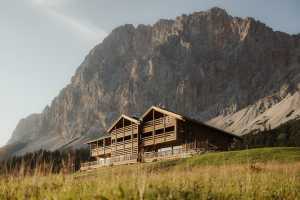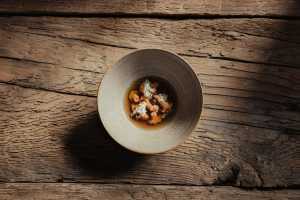For the brief, ill-fated two years I studied German at school, I was struck less by grammar than by its vocabulary. There are words like kummerspeck – translating to “grief bacon” which describes the weight gained from emotional eating, ohrwurm (meaning ear worm), meaning a catchy song lodged in your brain, and sitzfleisch (sit meat) – the endurance to survive something tediously interminable. It made the language feel, at least, refreshingly literal.
For the decade after Frau Fillingham gave up on me, I rarely encountered German words that made me pause. That changed this summer in Austria, at the foot of the Zugspitze mountain range above a village called Ehrwald, where I discovered a lexicon dedicated to alpine living that seemed almost therapeutic. There was heilklima (healing climate), bergweh (a yearning for the peaks), höhenrausch (high altitude-euphoria) and waldeinsamkeit – forest solitude, not loneliness but its restorative cousin. There is also einsamkeit im gebirge described by Nietzsche, a state of voluntary mountain solitude that has tempted philosophers and hermits alike for centuries. He would retreat to Sils-Maria, a Swiss village in the Engadin Valley, to string together some of his most quoted material. Meanwhile, Heidegger brooded in a modest hut in Germany’s Black Forest. I, considerably less profound, simply longed to disappear for a short while.

Eriro’s exterior
Alex Moling
After a start to 2025 that felt like undergoing major surgery without anaesthetic, the idea of vanishing into the mountains entirely felt magnetic. I was sure I needed a medical-grade dose of waldeinsamkeit – altitude, solitude, and pine-scented winds. I craved a destination where the only traffic was cows and falling asleep didn’t feel like an impossible task. NHS GPs may not dispense this tonic, but you can find it at a place called Eriro.
Recently named in Time Magazine’s World’s Greatest Places of 2025 list, Eriro is a nine-room inn marooned 1,550 metres up in the Zugspitze massif, which straddles the Austria-Germany border, accessible only by gondola. What makes it remarkable is what it lacks. Bedrooms have no TVs, technology is politely shunned – so no key cards, no electronic do-not-disturb signs, just labelled stones left by your door. Food is sourced within 30 miles, so don’t expect orange juice at breakfast or a consoling scoop of chocolate ice cream. Wi-Fi exists, but phone use is politely discouraged by Henning Schaub, the ebullient hotel manager, who suggests that complete immersion requires a little disconnection.
The hotel isn’t run by a faceless conglomerate but by three families from Ehrwald. The Posches are the visionaries, the Spielmanns the strategists, and Andreas Mader a carpenter and timber-construction expert. Planning permission up this high is as rare as a silent marmot, so Eriro occupies the exact footprint of Alpenglühen, the former historic nine-bedroom inn, now reborn with a basement spa. The alpine menu of diversions is broad, explains Hannes, the resident outdoorsman: paragliding, mountain biking, wood carving, horse riding, kayaking. Yodelling, however, is unavailable. I’m told the yodeller in question is increasingly challenging to track down these days.
Two wooden seats look out onto the mountains
Alex Moling
The view of the hay storage huts outside Eriro
Christy Spring
As a London cyclist usually sandwiched between buses and particulates, the promise of pedalling without respiratory compromise appeals, so I take an e-bike out on a spin on my first day. I pedal through cinematic, rain-darkened forest to Seebensee, a glacial lake where cows outnumber people, and their bells toll like a monastic gong recital. The ride is bracing, if not glamorous, as cow dung flicks from my tyre and lands onto my teeth at a mile in. Excrement expelled, I continue on foot up switchback scrambles to Drachensee, a bowl of meltwater cupped in a glacial cirque. I strip off and hurl myself in. For a few seconds (which felt heroic but were almost certainly less than ten), the meltwater snatches away my breath, my thoughts, and what feels like two years of cellular ageing.
The ride is bracing, if not glamorous, as cow dung flicks from my tyre and lands onto my teeth at a mile in
Hollow-stomached, I aim for the Coburger Hütte, a Tyrolean hut serving wurst and kaiserschmarrn – those torn, spongy pancakes buried under icing sugar and apple compote sweet enough to unseat a molar. At the till, I discover it’s a cash-only establishment. A tragedy worthy of Strauss. Despairing on the decking, two teenage boys save me with a Filofax of euros (their mothers, surely). We negotiate a bank transfer, and for those few moments, I am grateful that solitude has its limits.
Dinner back at Eriro is orchestrated by chef Alexander Thoss, a man in his late 20s who swims in Seebensee most mornings. I meet him at supper that night. He’s fox-like with round glasses, a mullet and a kind of dewy bounciness that London kitchens would have boiled out of him. There is no menu for breakfast, lunch, or dinner here: nine bedrooms mean diners eat identically. Thoss forages obsessively, so pine needles or mountain fungi often sneak in. Despite ingredients being sourced from within 30 miles of the hotel, the cooking isn’t bound by Tyrolean cliché either. We may eat chamois, dumplings, strudel and flädlesuppe (a soup made from consommé and omelette noodles), but we also devour whole roast spatchcock chicken with kimchi and kombucha-glazed chard, green beans dressed with vinegar and thinly sliced pears and even a ‘vanilla’ ice cream – made, in fact, not from vanilla, but from pumpkin. House-made bread is always served with a cloud-like pile of butter, seasoned with salt made from dehydrated pine needles, red onion skins or carrot peelings. Each meal is at once novel and comforting, with Thoss’ cooking proving that unprocessed, local, and seasonal cooking need not be one-note.
Cows by Seebensee
Christy Spring
Coburger Hütte
Christy Spring
Much like the food, the ceramics at Eriro also have provenance, made by local potter Steffi Pahle. I join her one evening in a class held under the eaves of Eriro, where we pinch clay into imperfect bowls, the silence broken only by the bark of a guest’s russet-furred dog, named Fuchs (fox in German), sitting at my feet. I once made pots obsessively, before a broken arm and London prices closed the studio door. To return to clay here, where most of our daily accomplishments are digital abstractions, feels grounding, even childlike. My wobbly bowls have since made the (no doubt extortionate) journey from Austria to Peckham, now stacked in my kitchen and proof that tactile things still matter.
Enter Tanya, Eriro’s holistic therapist and unofficial anarchist of exercise. She hosts a “fitness” class in the room next door to the pottery studio. I say “fitness” because before we start, she warns us not to expect anything; the class she leads is dictated entirely by her mood and energy levels. Tanya is a dainty, birdlike woman with ink-black hair and a personality that seems far too large to fit into such a small frame. We begin with stretches. Then, without warning, she has us sprinting in circles, shrieking like children let loose in a garden sprinkler. At one point, we pair up and attempt to twist one another into human pretzels, knees and elbows cracking like kindling. I glance around the room: the septuagenarians wear faces that vacillate between fear and disbelief, but they keep going, vertebrae popping obligingly. Tanya, unfazed, produces a gong and then we all lie on the floor, wrapped in blankets as she chimes. Fitness class? Séance? Exorcism? I’m not quite sure, but we all leave the room supple and surprisingly euphoric.

Mushroom broth
Alex Moling
On the final morning, cloud thwarts the planned sunrise hike. The mountains are erased, cows reduced to spectral smudges, so I decide to stay in and descend to the spa – Eriro’s womb. Three steaming onsen, a clutch of woollen hammocks and two saunas, one angled at the mountainscape, make it a place you’d imagine embryos might safely float. Then there’s the hay-bale room, lined floor to ceiling with dried grass and smelling faintly of Weetabix. In the centre are two heated, vibrating leather loungers that you repose in while Hans Zimmer swells in the headphones and drone footage of peaks rolls across a wide screen in front. It sounds absurd, because it is. Post-Zimmer, I sink into an onsen fed by mountain water said to heal a throng of ailments.
without warning, she has us sprinting in circles, shrieking like children let loose in a garden sprinkler
Alpine wellness, sleek as it seems, is hardly a modern invention. In 19th-century industrial Europe, factory workers abandoned soot-clogged cities for the mountains. The sanatoriums, Eriro’s primitive cousins, studded Austria, Switzerland, and beyond, offering state-funded recovery in rarefied air and expert supervision. They were miniature republics apart from reality, where strangers thought deeply, loved, argued, and convalesced together. The Black Forest was a favourite haunt for Russia’s literary set. Chekhov died in Badenweiler. The catalogue of consumptive geniuses rinsing their lungs (and minds) at high altitudes was almost comical in its excess.

Foraged alpine herbs
Alex Moling
Times have changed since sanatoriums. We know now that sunlight doesn’t disinfect, nor does fresh air cure tuberculosis. But a large part of their essence remains in Eriro. Dislocation from life itself: to step away from the news cycle, from catastrophes both global and personal, is, in my view, a luxury far richer than champagne or gilded hotels. To live in your own microcosm for a short period, to pedal through forest, sit among cows and soak in clouded silence where life is reduced to the simple acts of eating, sleeping, making and moving is the utmost luxury and a cure worth travelling for.
Rooms at Eriro start from £1,315 per night on an all-inclusive basis; for more information visit eriro.at
